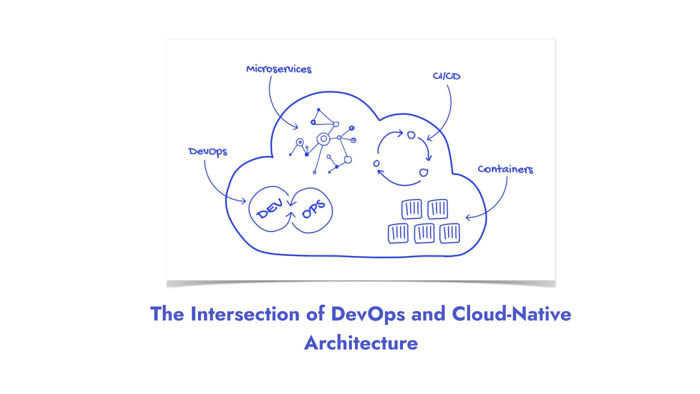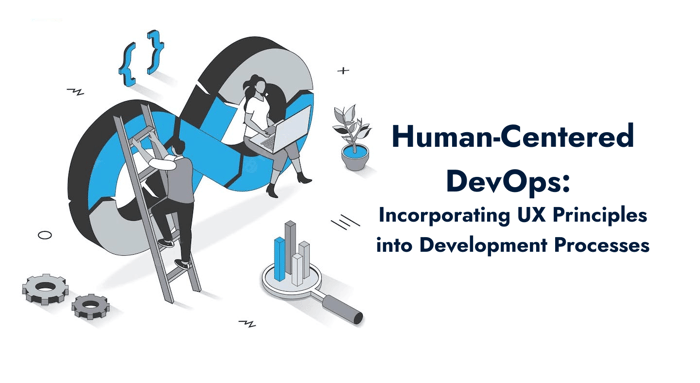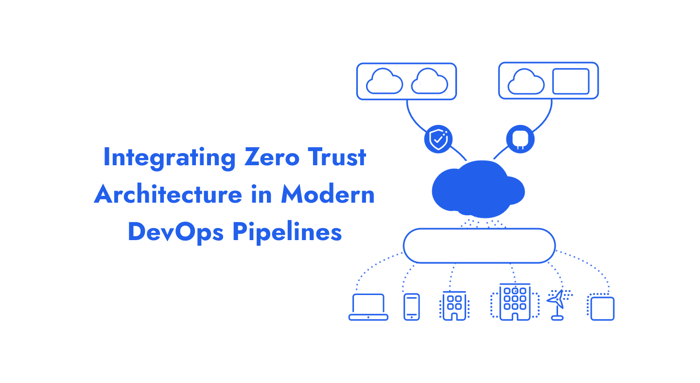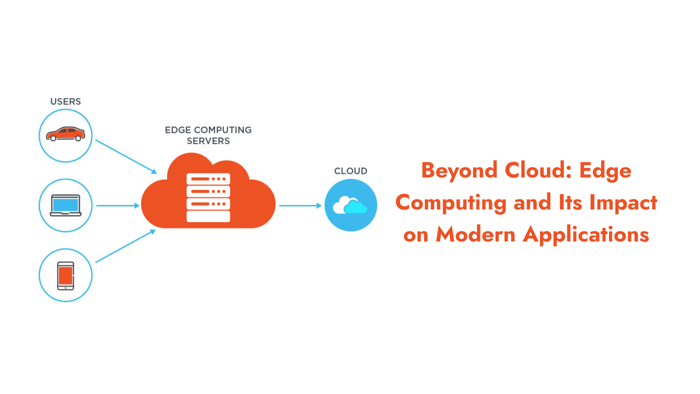Learn how DevOps and Cloud-Native architecture work hand-in-hand
In software development and IT operations, DevOps and cloud-native architecture have emerged as two significant concepts. DevOps is a methodology that combines software development with IT operations, aiming to shorten the development life cycle and provide continuous delivery with high software quality. Cloud-native architecture, on the other hand, is a method of building and running applications that exploit the advantages of the cloud computing model.
When used together, these approaches offer enhanced organizational agility and efficiency in software development. DevOps streamlines processes and fosters collaboration, while cloud-native architecture offers scalability and resilience, rooted in the cloud environment.
This article aims to provide a clear understanding of how these two domains interact and support each other. It covers the latest trends and best practices and explores how adopting these strategies can be beneficial for businesses striving for technological advancement and efficiency. This article aims to offer valuable insights to IT professionals, as well as anyone interested in cloud computing and software development.
The Evolution of DevOps in Cloud-Native Environments
The journey of DevOps in the landscape of cloud computing is a story of continuous evolution and adaptation. Initially, DevOps emerged as a set of practices aimed at unifying software development and IT operations. The goal was straightforward but ambitious: improve collaboration, increase deployment frequency, and bring more agility to software development. As cloud technologies started gaining prominence, DevOps naturally found its place, leveraging the cloud’s flexibility and scalability to further its objectives.
This integration with cloud technologies marked a significant shift. It was no longer just about faster software development cycles; it was about building and deploying in an environment that was inherently flexible, scalable, and distributed. The cloud's ability to provide on-demand resources dovetailed perfectly with DevOps' need for speed and efficiency, leading to what we now know as cloud-native DevOps.
Several key trends have emerged within this sphere:
- Data Observability: This involves understanding and managing data in complex systems, automating monitoring and troubleshooting in data pipelines to enhance productivity and communication.
- Serverless Databases: These represent a shift towards databases that automatically manage the underlying infrastructure, allowing developers to focus more on building applications than managing database servers.
- FinOps: This practice aligns financial goals with cloud spending, ensuring cost-effectiveness in cloud investments.
- eBPF and WASM: These technologies are driving innovations in observability, monitoring, and security within network and service meshes.
- Supply Chain Security: In response to increased attacks, this has become crucial in managing software supply chains more securely.
- Low-/No-Code Platforms: These platforms are simplifying and democratizing application development, making it accessible to a broader range of users.
- Developer Experience as a Decision Driver: This underscores the importance of providing a seamless, efficient experience for developers in cloud environments.
These trends, highlight the dynamic nature of DevOps in cloud-native settings, continuously adapting and evolving to meet the demands of modern software development and deployment.
2024 Trends in DevOps and Cloud-Native Technologies
In 2024, the landscape of DevOps and cloud-native technologies is not just evolving; it's undergoing a revolutionary transformation. Several key trends are poised to reshape how organizations approach software development, deployment, and infrastructure management, steering them towards more efficient, scalable, and collaborative futures. These trends include:
- CI/CD 2.0: This new wave in Continuous Integration and Continuous Delivery incorporates advanced automation and machine learning, leading to smarter, faster, and more reliable code deployment.
- Serverless Architecture: Gaining mainstream traction, serverless computing allows developers to focus on writing code rather than managing infrastructure, enhancing scalability and reducing operational overhead.
- Kubernetes and Cloud-Native Technologies: Kubernetes continues to dominate container orchestration, facilitating the deployment, scaling, and management of containerized applications across various environments.
- Multi-Cloud and Hybrid Cloud Strategies: Organizations are increasingly embracing these strategies to mitigate risks, avoid vendor lock-in, and optimize costs and performance.
- AIOps Integration: Artificial Intelligence for IT Operations is becoming integral to DevOps, automating incident response, predictive analysis, and root cause analysis, thereby enhancing system reliability and performance.
- GitOps: This framework uses Git repositories as the source of truth for infrastructure and applications, streamlining collaboration and ensuring auditable and reproducible infrastructure changes.
- Edge Computing: With the rise of IoT and demand for low-latency applications, edge computing processes data closer to the source, reducing latency and enhancing real-time processing.
- DevSecOps: Integrating security into the DevOps process ensures security is a fundamental part of development and deployment.
- Quantum Computing in Development and Testing: While still emerging, quantum computing is being explored for its potential to solve complex problems and enhance computational capabilities.
- Focus on Observability and Metrics: Enhanced tools and practices are being prioritized to provide deeper insights into application performance and behavior.
These trends indicate a move towards more sophisticated, efficient, and secure approaches in DevOps and cloud-native technologies.
How DevOps Enhances Cloud-Native Architecture
DevOps and cloud-native architecture are not just partners in modern software development and IT operations; they are co-creators of a new era of digital innovation. The synergy between DevOps and cloud-native architectures is not just evident; it's transformative, offering a combined force that significantly boosts the efficiency, scalability, and agility of software delivery processes.
Interdependencies and Synergies
At the core of their relationship, DevOps brings a culture of rapid, iterative development, continuous integration, and automation, which aligns perfectly with the scalable and flexible nature of cloud-native environments. Cloud-native architecture, with its focus on microservices, containers, and serverless functions, offers the perfect playground for DevOps practices. This environment allows for rapid deployment, easy scaling, and efficient resource utilization. DevOps, in return, ensures these cloud-native elements are integrated seamlessly, managed efficiently, and delivered continuously with a high degree of reliability.
A notable example of this interplay is seen in how organizations leverage Kubernetes, a cloud-native tool, to orchestrate containerized applications. DevOps teams use Kubernetes to automate the deployment, scaling, and management of applications, making these processes more efficient and error-free.
Another example is the use of CI/CD pipelines in deploying microservices architectures. These pipelines, a hallmark of DevOps, enable organizations to deploy individual components of their application independently and more frequently, a capability that is central to cloud-native architectures.
Moreover, the use of serverless technologies like AWS Lambda and Azure Functions demonstrates how DevOps practices enhance cloud-native environments. These technologies allow DevOps teams to focus on writing code that adds business value, rather than managing infrastructure, thus speeding up the development cycle and improving operational efficiency.
In these examples, and many more, DevOps principles don't just support cloud-native technologies; they elevate them, enabling organizations to achieve greater agility, scalability, and resilience in their software development endeavors.
Best Practices and Common Patterns in Cloud-Native DevOps
Building on the harmonious relationship between DevOps and cloud-native architectures, there are several best practices and common patterns that organizations can adopt to maximize the benefits of this integration. These practices not only streamline development and operations but also ensure that the software delivery is swift, secure, and scalable. These practices include:
- Automation: The Heart of Cloud-Native DevOps: Automation is the backbone of efficient cloud-native DevOps practices. It encompasses everything from code deployment to infrastructure management. In cloud-native environments, automation enables the rapid provisioning and scaling of resources, ensuring that applications are always running optimally. Tools like Terraform and Ansible play a pivotal role here, automating the setup and maintenance of cloud infrastructure.
- Continuous Integration and Continuous Delivery (CI/CD): CI/CD pipelines are critical in cloud-native DevOps, allowing teams to integrate new code changes frequently and reliably. This practice ensures that the code is always in a deployable state. Using tools like Jenkins, GitLab CI/CD, and GitHub Actions, DevOps teams can automate the testing and deployment processes, reducing the chances of human error and speeding up the release cycle.
- Security: A Priority in Every Step: In cloud-native DevOps, security is integrated into the development process from the outset – a practice often referred to as DevSecOps. This approach involves incorporating security checks and balances throughout the CI/CD pipeline, ensuring that security considerations are not an afterthought but are baked into the development process.
- Monitoring and Feedback Loops: Effective monitoring is crucial in cloud-native environments. It provides insights into application performance, user experience, and system health. Tools like Prometheus and Grafana are often used for monitoring, offering real-time data and alerts. This continuous feedback loop allows DevOps teams to quickly identify and rectify issues, ensuring high availability and performance of applications.
By adhering to these best practices, organizations can leverage the full potential of cloud-native DevOps, fostering an environment of continuous improvement and innovation.
Cultural Considerations in Cloud-Native DevOps
The adoption of cloud-native DevOps transcends mere technological implementation; it necessitates a fundamental shift in organizational culture. This shift is crucial for reaping the full benefits of cloud-native DevOps, as it's not just about deploying new tools and processes but about nurturing a mindset and environment conducive to these practices.
Fostering a Culture of Collaboration
In cloud-native DevOps, collaboration is key. It breaks down silos between development and operations teams, encouraging a more integrated approach to software development and deployment. This collaborative spirit extends beyond just these teams, involving quality assurance, security, and other stakeholders in the process. Open communication and shared responsibilities become the norm, fostering a more cohesive and effective working environment.
Agility: Adapting Quickly to Change
Agility is another cornerstone of a successful cloud-native DevOps culture. It's about being able to respond quickly to market changes, customer needs, and technological advancements. This agility is achieved not just through technology but through an organizational willingness to embrace change and adapt processes accordingly. It means being open to experimenting, learning from failures, and continuously improving.
Emphasis on Continuous Learning and Improvement
Continuous learning is an integral part of the cloud-native DevOps ethos. The technology landscape is ever-evolving, and staying abreast of the latest trends, tools, and best practices is essential. Organizations need to invest in ongoing training and development, encouraging their teams to gain new skills and knowledge. This learning culture fosters innovation and keeps the organization at the forefront of technological advancements.
By prioritizing these cultural aspects – collaboration, agility, and continuous learning – organizations can create a fertile ground for cloud-native DevOps to thrive, leading to more effective, efficient, and innovative software development and deployment.
Future Outlook and Emerging Innovations
As we look towards the future, the fields of DevOps and cloud-native architectures are poised for significant transformation, driven by emerging technologies and evolving trends. These innovations promise to redefine how we approach software development, deployment, and operations, ushering in a new era of efficiency and capabilities.
AI and Machine Learning: Enhancing Automation and Efficiency
Artificial Intelligence (AI) and Machine Learning (ML) are set to play a pivotal role in the evolution of DevOps and cloud-native architectures. These technologies can automate complex tasks, optimize workflows, and predict potential issues before they arise. For instance, AI-powered analytics can provide deep insights into application performance and user behavior, enabling more proactive and data-driven decision-making. Machine Learning models can also enhance continuous integration and delivery processes, fine-tuning them for efficiency and reliability.
Quantum Computing: A New Frontier for Problem-Solving
Quantum computing, while still in its nascent stages, holds immense potential for DevOps and cloud-native architectures. Its ability to process complex calculations at unprecedented speeds could revolutionize various aspects of software development and deployment. Quantum computing could, for example, drastically reduce the time required for data-intensive tasks like testing and debugging, or optimize resource allocation in cloud environments.
The Impact on DevOps and Cloud-Native Architectures
The integration of these emerging technologies into DevOps and cloud-native architectures is not just about enhancing existing processes; it's about opening up new possibilities. AI and ML can transform how we manage and operate cloud-native systems, making them more adaptive and intelligent. Quantum computing could solve problems that are currently intractable, leading to breakthroughs in software development and infrastructure management.
As we move forward, the integration of AI, ML, and quantum computing into DevOps and cloud-native architectures is likely to create more dynamic, intelligent, and efficient environments, offering exciting opportunities for innovation and advancement in the field.
Conclusion
As we've explored the intersection of DevOps and cloud-native architectures, it's clear that their integration is not just beneficial but essential for modern development success. The confluence of DevOps practices with cloud-native principles has paved the way for more agile, efficient, and scalable software development and operations.
Key Takeaways
- The evolution of DevOps in cloud-native environments highlights a shift towards more collaborative, automated, and efficient practices, with key trends such as Data Observability, Serverless Databases, and FinOps redefining the landscape.
- The 2024 trends in DevOps and cloud-native technologies, including CI/CD 2.0, Kubernetes, AIOps, and Edge Computing, indicate a future of enhanced automation, intelligence, and security.
- The synergy between DevOps and cloud-native architecture enhances operational efficiency, with automation, CI/CD, security, and monitoring being critical components.
- Organizational culture plays a pivotal role in the successful adoption of cloud-native DevOps, with collaboration, agility, and continuous learning being key cultural pillars.
- Looking ahead, emerging technologies like AI, machine learning, and quantum computing are set to significantly influence and transform DevOps and cloud-native architectures.
The integration of DevOps with cloud-native architecture is more than a technical strategy; it's a comprehensive approach that aligns technology with business goals. By embracing these practices, organizations can not only navigate the complexities of today's digital landscape but also position themselves for future innovations and challenges.
We encourage our readers to explore deeper into these practices, explore their vast potential, and consider how they can be implemented within your organizations.
Akava would love to help your organization adapt, evolve and innovate your modernization initiatives. If you’re looking to discuss, strategize or implement any of these processes, reach out to [email protected] and reference this post.





